11+ Sample Telecommuting Proposal
-
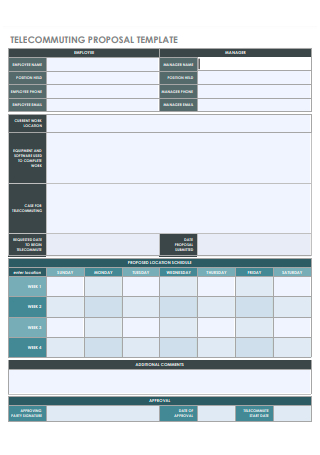
Telecommuting Proposal Template
download now -
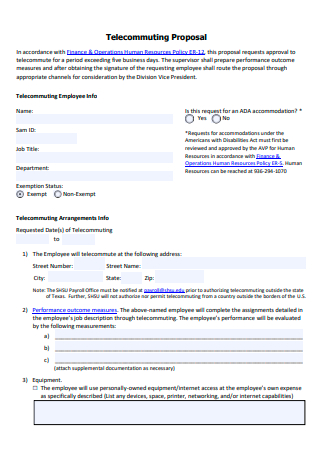
Basic Telecommuting Proposal
download now -
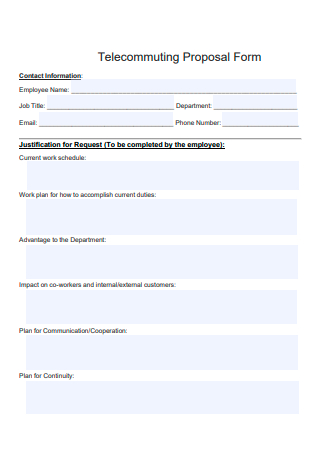
Telecommuting Proposal Form
download now -
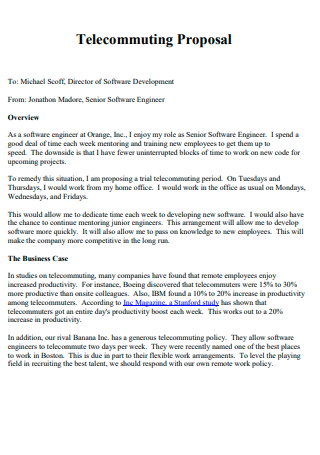
Telecommuting Proposal Example
download now -

Telecommuting Employment Proposal
download now -
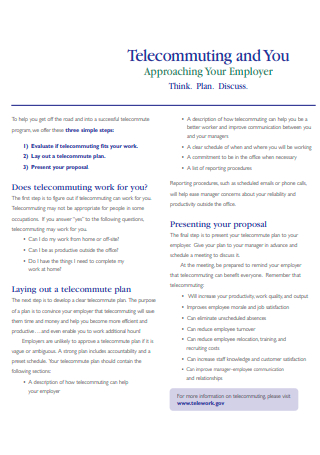
Standard Telecommuting Proposal
download now -
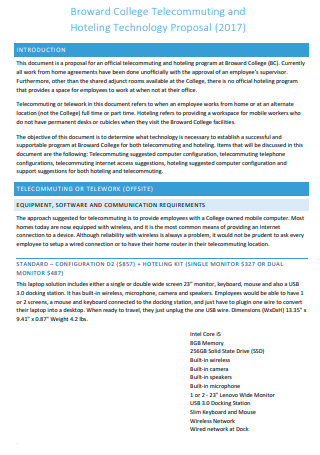
Telecommuting and Technology Proposal
download now -

Telecommuting Report Proposal
download now -
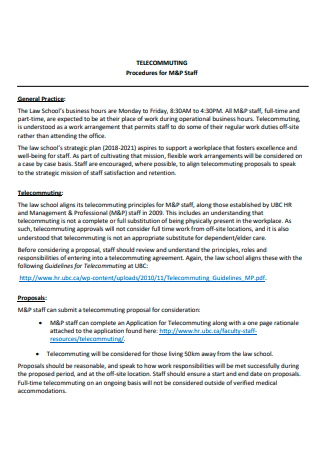
Telecommuting Procedure For Staff Proposal
download now -
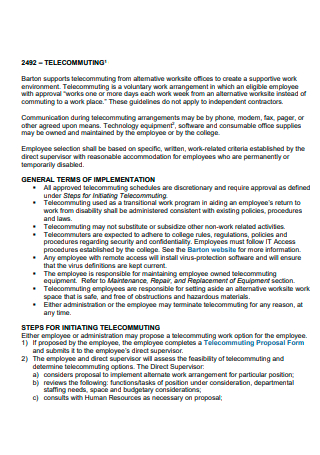
Telecommuting Proposal in PDF
download now -
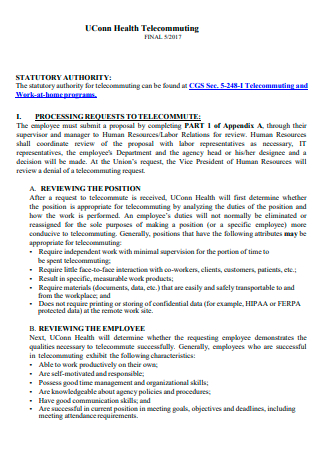
Health Telecommuting Proposal
download now -
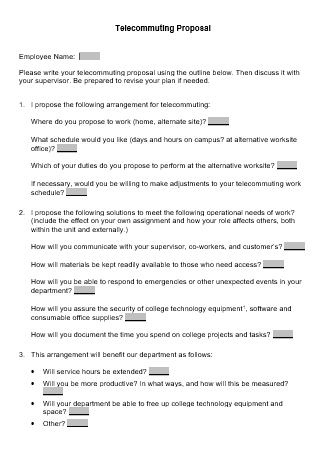
Telecommuting Proposal in DOC
download now
What Is Telecommuting?
It is defined as the capacity of any employee to complete work assignments outside of the traditional workplace using telecommunications means such as chat, video apps, email, and the telephone. Some employees will be referred to as remote workers, indicating that they work outside the office more frequently than inside. There are numerous advantages to telecommuting. Employees will have a more flexible work schedule, won’t have to deal with workplace interruptions, reduced commuting costs, more productivity, increased employee loyalty, a better work-life balance, and can save significant money and expenses. Globally, approximately 18 percent of people work full-time from a remote location, according to remote work data.
Benefits of Telecommuting
There are numerous advantages associated with telecommuting. Moreover, the benefits extend to employees and employers, so everyone stands to gain. Here are the top seven advantages of telecommuting and why your organization may wish to experiment with this work style:
Tips For Telecommuting
It is essential to know these telecommuting ideas while learning to locate remote work. Even though remote work statistics indicate growth, other organizations have infamously attempted and failed remote work. Since different organizations that employ remote workers are victorious, remote work is not to blame. Some businesses can benefit from telecommuting, while others cannot. If you are not in the appropriate remote position, your remote work experience will likely reflect this. No amount of telecommuting advice will be able to fix this situation. There are numerous ways to discover remote employment. Still, the following four suggestions for telecommuting can help you in the practical telecommuting jobs.
1. Love Your Work
One of the essential suggestions for thriving with work-from-home employment is to choose something you enjoy – not simply tolerate. In most remote jobs, your telecommuting performance depends on your ability to identify suitable remote work. You will perform best when you are engaged in an exciting activity. The most excellent remote jobs of 2020 or the best company to work for will depend on your tastes and individual circumstances. Selecting a career that fosters an environment you enjoy is preferable. Remember that there will inevitably be positives and cons associated with remote work in any organization. For instance, if you’re used to seeing coworkers daily in the office, it’s easy for loneliness to creep in if you’re always telecommuting from home. Forming the same bonds with teammates online as you would over the water cooler can be challenging.
2. Find Remote Positions You Delight In.
Since it is crucial to enjoying your work, all the teleworking strategies in the world won’t help if you don’t know how to locate remote work opportunities. If you already have work that permits telecommuting and enjoys it, you can skip to the next step. Otherwise, continue reading for telecommuting employment suggestions.
3. Stay Visible
In a traditional office, it is difficult to be forgotten. You attend meetings, engage with supervisors and coworkers, and leave an impression. This, however, can change when working remotely. Without a deliberate effort to maintain visibility, it is simple to be forgotten. You will be overlooked for promotion and miss out on critical networking chances that could boost your career if you reduce your workload. This lack of exposure may be of more significant concern if you telecommute for a company where your coworkers work in a regular office and you work entirely remotely. In light of this, one recommendation for telecommuting is to focus on how to locate remote jobs. Fully remote organizations are likelier to have fostered a culture in which remote workers maintain visibility.
4. Communicate as though your jobs depend upon it
One of the significant disadvantages of remote employment can be communication challenges. Many company leaders argue that when a team is physically co-located, things “move faster.” However, telecommuting does not preclude communication; it simply requires more effort. There are numerous tools for facilitating a remote conversation. Still, installing software is insufficient for skill development.
How To Request For a Work From Home Setup
Increasing numbers of workplaces permit employees to work remotely. Nonetheless, it may appear futile if unavailable at your office. In the year 2021, this statement is entirely false. It is no longer viable for a manager to state that working from home is impossible, as millions of workers worldwide have proven they were more productive at home than in the office during the pandemic. While some firms adapt to this new environment, others insist that employees return to the office. If you are one of the many employees who wish to continue working from home, but your employer is unsure, don’t hesitate to make your case. Follow the below steps to convince even the most dubious supervisors to allow you to work remotely:
1. Research the competitive environment in your sector and company
When engaging in remote job negotiations, it is vital to be well-prepared. This involves understanding the remote work landscape in your business and organization. Determine the prevalence of remote work in your field using online tools. Determine if or not your company’s competitors provide remote work alternatives by conducting additional research. Ultimately, your management should provide comparable perks to avoid losing good personnel. Finally, inquire within your workplace and firm to determine if any teams or departments already have remote work arrangements. Unknown to you, your firm may even have a remote work policy. This information will allow you to demonstrate to your manager that remote work is more prevalent than they believe and to provide concrete instances of how the arrangement has worked in comparable situations.
2. Highlight the benefits to your company
Include a summary of the advantages of a remote work arrangement for your employer in your negotiation. This may include potential cost savings, enhanced morale, and enhanced production. You wish to reassure your boss that this arrangement benefits everyone, not just yourself. There is no need to conceal the fact that working will provide you with personal benefits, such as shorter commutes or greater schedule flexibility. Still, it would help if you also regarded the advantages for your manager. You will likely need to educate your supervisor if you work in a setting where teleworking is uncommon or even frowned upon. Possessing a few essential data about how employers gain from remote work could bolster your argument. Still, unless your supervisor is exceptionally nerdy, it’s better not to overwhelm them with a large number of figures.
3. Create a detailed plan for remote work
After you’ve done your research, make a short document that explains how your remote work arrangement could work. This should include a schedule for the days you’ll be working from home and a summary of how you’ll communicate and keep track of your work. You might even want to suggest digital tools for managing projects and communicating with people who are far away. Ultimately, your goal should be to handle any problems that working from home might cause from your boss’s point of view and make it clear that they don’t have to do any extra work to manage the arrangement. It should also ensure that you can work just as well, or even better, from afar. Help your boss say yes as much as possible.
4. Timing your request with care
Your proposal to work remotely will only be granted if your supervisor already respects and values your work. Even if this is generally true, it can be advantageous to time your request immediately after completing a large project you’ve led or when your employer is impressed with your performance. Set the stage weeks or months in advance by proactively building a strategy for assessing and regularly discussing your success with your supervisor. When the time comes to request remote work, your supervisor will be aware of your value as an employee, and you will also have a mechanism to evaluate your performance.
5. Ask in person, not via email
Do not approach your manager in passing or via email with your request. If you routinely check in and have the time, bring it up at that time. If not, you should request a meeting. To avoid rapid rejection, do not state beforehand that you wish to discuss remote employment. The meeting’s tone should reflect your relationship with your supervisor. The talk can be more casual if you are close than if your connection is exclusively professional.
6. Come prepared to lead the meeting
Make sure you’re ready to lead the conversation with your boss by doing your research and getting prepared. Start by talking about your desire to work from home in a general way. Talk about the benefits for your company and how common it is where you work and in your industry. Give some examples of recent projects you worked on where you managed your time and tasks well and ahead of time. Your boss can see from these specific examples that you can handle the responsibility of working alone from home. Then make your request, and be clear about what you want. Even if you don’t get what you want, it’s an excellent place to start. Don’t give your boss your typed proposal right away.
7. Expect some discomfort, but resist discouragement
Even though it’s becoming more common, many workplaces still don’t trust people who work from home. You should expect that your boss might have doubts and some of your coworkers might even be angry. Position yourself as a leader who can help the rest of your company, not a standout who should be admired. But don’t give up because it hurts. It’s uncomfortable to negotiate. Change is hard to deal with, but having a flexible job is worth it.
FAQs
How do you pitch telecommuting?
Propose an effective communication plan to your manager in which you can explain your working hours weekly (and sometimes daily) and how to reach you. It would benefit if you also recognized that flexibility works in both directions.
What is an example of telecommuting?
Telecommuting is a work placement in which workers work away from the employer’s office. Typically, this entails working from home or nearby, such as a coffee shop, library, or coworking space.
Is telecommuting a good idea?
Studies have shown that telecommuting makes employees happier and less stressed. Fewer interruptions can result in increased productivity. Employees frequently work longer hours when they do not have a commute can also contribute to a rise in productivity.
Not all businesses or vocations are suitable for telecommuting. As alternatives for remote work and remote collaboration expand, however, more firms are contemplating telecommuting as a standard component of employee schedule. Start drafting a telecommuting proposal if you wish to convert your current position into a remote one. Even if the talk ends up being more casual, a recommendation will assist you in organizing your thoughts and making the most robust case possible for your new arrangement.
